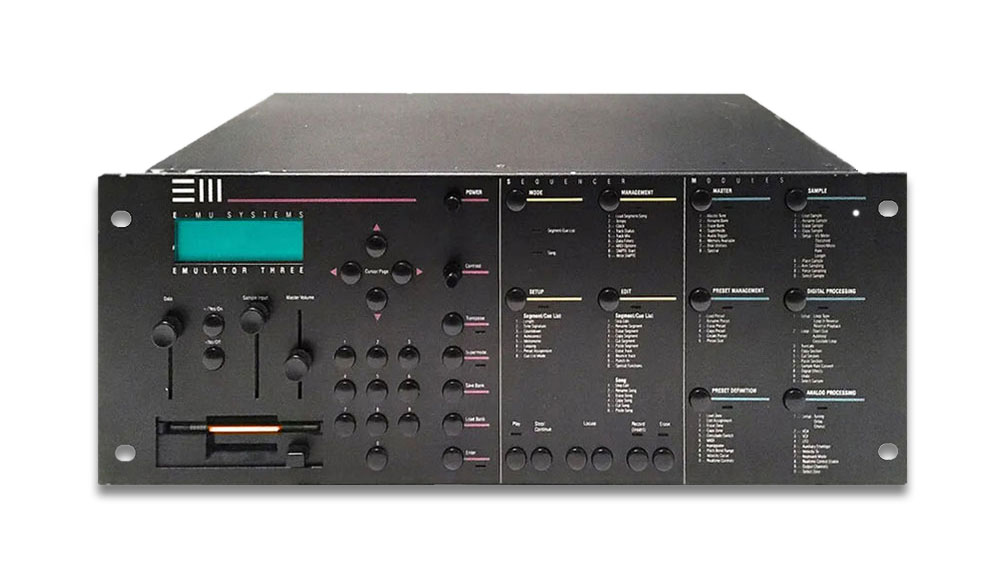E-MU EMULATOR III - The King of Sampling That Transformed Music Production

In 1987, the American company E-mu Systems introduced the Emulator III, which became a groundbreaking sampling workstation of its time. This instrument was not just another step in the evolution of sampling – it was a revolutionary leap that brought CD-quality sound, a powerful sequencer, analog filters, and expanded MIDI integration.
Emulator III became the flagship of studio production, used in film music, pop hits, and avant-garde electronic compositions. Its rich sound character and flexible editing capabilities secured its iconic status, which musicians and producers still appreciate today.
Technological Revolution – What Did Emulator III Introduce?
The First Sampler with 16-bit Sound
Emulator III was the first sampler to offer CD-quality sound – 16-bit stereo sampling at 44.1 kHz. This provided incredible clarity and detail, previously available only in the most expensive studio systems.
Expanded Memory – Up to 8 MB RAM
While previous models had limited memory, Emulator III allowed an expansion of up to 8 MB RAM, enabling longer samples, more complex layering, and greater flexibility in editing.
Built-in 16-track Sequencer
Emulator III was not just a sampler – it was a fully-fledged workstation. Its built-in 16-track sequencer enabled complete song creation, making it a standalone production tool.
Analog Curtis CEM3387 Filters
One of the biggest advantages of the Emulator III was its analog Curtis CEM3387 filters, which were part of each voice. These filters provided a warm, organic sound, which was rare in the digital world.
MIDI, SMPTE, and SCSI – Seamless Studio Integration
Emulator III was designed to communicate seamlessly with other studio devices. Thanks to MIDI, SMPTE synchronization, and a SCSI interface, samples could be quickly transferred, sequences synchronized, and the sampler connected to a computer.
Sound Architecture – How Did Emulator III Shape Music?
High-Fidelity Sampling
With its 16-bit depth and 44.1 kHz sampling frequency, Emulator III provided incredibly clean sound, ideal for orchestral samples, realistic instruments, and experimental tones.
Filters and Envelopes for Synthesis
Emulator III was not just a sampler – it was a hybrid synthesizer. Thanks to its resonant analog filters and complex envelopes, it was possible to shape sounds similar to those of analog synthesizers.
Multitimbral Mode and Layered Sounds
Emulator III allowed up to eight simultaneous layers of sound, which was perfect for rich orchestral arrangements, complex synthetic textures, and realistic instrument combinations.
Expanded Sample Editing Features
Emulator III introduced advanced digital processing, including looping, truncation, sample rate conversion, and internal effects, allowing precise sample manipulation.
Built-in Arpeggiator and Real-Time Control
This sampler featured a built-in arpeggiator and velocity-sensitive key response, enabling expressive playing and better control over sound dynamics.
Memory Management and Disk Utilities
Emulator III included advanced disk tools for quickly organizing sound banks, presets, and sequences, significantly easing studio workflow.
Macintosh Integration
Emulator III could be connected to a Macintosh computer, enabling graphical sample editing. This was a significant advantage, as the built-in display was relatively small, making detailed editing more challenging.
The Wave of Samplers in the Late '80s – How Did Emulator III Influence the Competition?
Emulator III appeared at a time when samplers were becoming an essential part of music production. Its biggest competitors were Fairlight CMI III and Akai S1000, but its sampling philosophy, analog filters, and studio integration made Emulator III the preferred choice for many artists.
Fairlight CMI III vs. Emulator III
Fairlight was considered a premium system, used mainly in high-end studios. It offered a graphical interface, but its operation was slower and less intuitive than Emulator III. Moreover, Emulator III introduced 16-bit stereo sampling, whereas Fairlight was still limited to 12-bit resolution.
Akai S1000 vs. Emulator III
The Akai S1000 was more affordable, had powerful MIDI integration, and expanded memory options. However, its digital filters lacked the organic character of Curtis analog filters in Emulator III. Musicians seeking warmer, deeper sound often opted for Emulator III instead.
Iconic Samples Created on Emulator III
Thanks to its rich sound architecture, Emulator III produced some of the most famous samples that shaped late-'80s and early-'90s music.
Orchestral Samples in Film Music
Hans Zimmer and other film composers used Emulator III to create epic orchestral arrangements, which became fundamental to Hollywood soundtracks.
Electronic Textures of Depeche Mode
Depeche Mode used Emulator III to craft dark synthetic pads, which defined their signature electronic sound on the album Violator.
Peter Gabriel and African Rhythms
Peter Gabriel used Emulator III to sample African percussion and vocals, creating a unique fusion of live sounds and digital production.
Other Famous Users
Among musicians who used Emulator III were also Genesis and Jellyfish, highlighting its influence not only in electronic music but also in progressive rock and alternative music.
Emulator III was used by many artists, including:
• Jean-Michel Jarre – Ambient and synthetic soundscapes.
• Trent Reznor (Nine Inch Nails) – Industrial experiments.
• Vangelis – Film music and epic orchestral samples.
• The Cure – Alternative rock with electronic elements.
• David Bowie – Innovative production in the '80s and '90s.
• Enigma – Mystical ambient sounds.
• Hans Zimmer – Film scores featuring rich orchestral samples.
• Peter Gabriel – Pioneer of sampling in pop music.
• Depeche Mode – Iconic electronic textures.
• etc.
Conclusion
Emulator III defined a new era of sampling, and its technology continues to influence the way digital sound is handled. With CD-quality sound, analog filters, and revolutionary editing capabilities, it became a studio production icon that influenced the music world for decades. Its warm, rich sound and flexible editing options make it a timeless instrument that musicians and producers still value today.
| |
|
|
|
|
|
|
|
|


